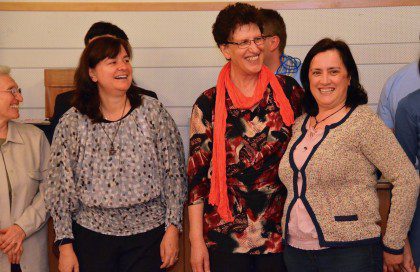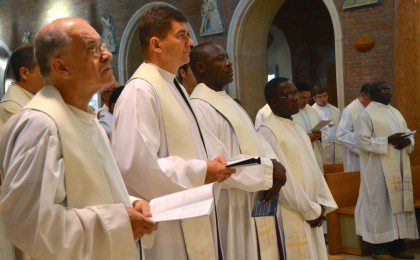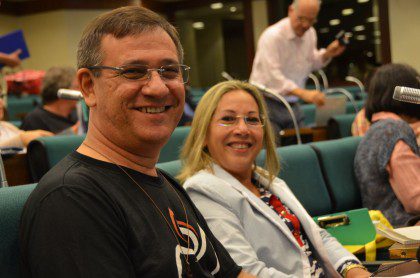
Sharing our Dehonian Charism
Letter on the occasion of the Feast of the Sacred Heart of Jesus
June 27, 2014
To all SCJs; to all members of the Dehonian Family
Introduction
From May 15 to 20 this year, the Dehonian Family gathered in Rome. The meeting reminded us that we, the Congregation, are not the only ones who have been the recipients of the gift of the charism of Léon Dehon. We reflected together with those who have found in his faith experience their orientation to Jesus Christ, how we may live and pass on to others what we all, in different ways, have received as a gift from the Spirit.

As we approach the feast of the Heart of Christ, we want to take the opportunity to reflect on this gift so that we may not hesitate to make it available to others. Our Rule of Life says that it is our call: “to make this charism effective by responding to the urgent needs of the Church and of the world.” (#1) Others, such as the Compagnia Missionaria, the Movimento dell’Amore Misericordioso del SCJ, the Fraternità Mariana del Sacro Cuore, a number of consecrated women, and many groups of Lay Dehonians, young and old, throughout the world join us in this mission. During the meeting of the Dehonian Family we have approved together a “Spiritual Path for Lay Dehonians” to help us in this mission together.
This letter is therefore an encouragement first of all to us, religious, consecrated and lay, to spread the distinctive reading of the scriptures that Léon Dehon left us as his legacy. And as we have just renewed and celebrated our bond with the whole Dehonian Family, let us to do it together with those who share this vision.
1.Gifts of the Spirit
No one may claim as his or her own the gifts of the Spirit. They have been given in the total freedom of the Spirit who like “the wind blows where it chooses … you don’t know where it comes from or where it goes.” (John 3.8) With the Church we believe that Léon Dehon was the recipient of such a gift of the Spirit. We are its witnesses. But we, as Priests of the Sacred Heart, cannot claim sole ownership. His was a gift to the Church. And, as Jesus said, from there it blew where it will.
For what else does a charism mean than to see the world through the eyes of the Spirit? And what else can this Spirit-gift mean than to see our world and our life through agape, through love? For Léon Dehon this seeing of the world through agape-love began through his attachment to the devotion to the Sacred Heart. Initially, he thought that he had found it in the overly mystical way of the Soeurs Servantes. Later, with the Consummatum est, when this way was found to be too much a search for security and proof, he dared to trust more and more his own, unique experience of the love of God. His became a search for the source of life in love. Blocked from looking for this source in signs, he found confirmation in the words of scripture. He became a devourer of the Word of God. And what he found was the original word of love, an infinite gratuitousness that pervaded everything.
Our Rule of Life rightly points to two sources in scripture for this discovery of Léon Dehon (#2). One is the beautiful acknowledgement of Paul in Galatians (2.19-20) of his being crucified with Christ so that now “it is no longer I who live but Christ who lives in me.” It gave Paul the assurance that allowed him to live “by faith in the Son of God who loved me and gave himself for me.” A deep faith in love – in God’s love – for him: that was Paul’s mystical experience. Those of us who know Léon Dehon recognize this mystical confiance also in his life. The second scripture passage gives us the image of “the open side and pierced Heart of the Savior”. This is an image of a humbler-yet God, who “handed over” Jesus to enter fully in the lives of people – up to death, Paul says – to show his mercy and compassion. In a meditation, Léon Dehon writes, “I need to contemplate this wound to see how much I am loved, and how much I should love in return.”[1]
This in short was the image of God that had imprinted itself on the soul of Léon Dehon. Yes, a high God – full of majesty and glory – yet also a just God, who, as he likes to quote from Psalm 113, “raises the poor from the dust, and lifts the needy from the ash heap … who gives the barren woman a home: a laughing mother of children.” Throughout his life Léon Dehon juggled between these two aspects of God: a God of justice and a God of love. For Léon Dehon and for the tradition that he sought to appropriate, it was never enough to allow our identities to be delineated only by love. For him it was always love and… love and reparation – love and immolation – love and oblation. Well, he knew in his own heart the complaint which Jesus uttered to Margaret Mary for humanity’s ingratitude and contempt before God’s love. He made it his own impulse to join Christ in his suffering to make up for what was lacking.
Throughout his life he lived the powerful interplay of love and justice. He struggled all his life to believe in God’s love. For him, as for us, it is not easy to accept that one is loved. But he believed in it enough to become indignant about the suffering of the workers and their families. His God of love did not just cover over all the inhumanity around him. The God of love also gave responsibility and autonomy to people. And like the prophets of old he knew therefore also the God of anger, who lashed out against injustice. We only need to read again his Christmas sermon of 1871 or his Roman Conference of 1897. His was a God, whom humans could not love if they did love one another. For Léon Dehon this was not just a theological insight. It was something that he felt from within. And so, as a charismatic and a mystic, he was someone who was in love, in love with the world, but this love was also infused, in the beautiful words of Dorothy Sölle, “with anger in the belly.”

This indignation is not strange to us. We too know it “in the belly” in the evil that is done to the other by the traffickers of women and children, the abusers of children, war merchants and drug dealers, fanatical terrorists, and the greedy from the financial sector. Léon Dehon shared this indignation, but his “anger in the belly” led to an active seeking of liberation, reparation: a life for others. In the “acts of oblation” he showed how, for him, this inhumanity was also a “complaint of God” against humanity.
But this indignation, this anger because of injustice, was, however, constantly counterbalanced with mercy, with God’s agape-love. He always retained the disproportion between justice and love. He knew love to be of an order that is infinitely elevated above the order of justice. He learned it from Jesus for whom love always played the upper register, set against the deeper melody of life. In the beautiful image of Roger Burggraeve, “We must breathe out of two lungs: mercy and justice.”[2] That is Léon Dehon to the core.
The lay Dehonian members are at times better situated to give witness to this interplay of love and justice because their role to bring to bear the reign of God in the Heart of Christ is more directly engaged with the issues of justice and injustice in society. They can help the religious to fulfill the common mission to create “the community of charity.”(Const. 2)
2.The “pierced side” as a biblical key
There exists a hesitation among Dehonians to share our charism, our spirituality, with the people among whom we work and live. There is a sense that to speak of the Sacred Heart or the Heart of Christ no longer finds a resonance among people. It may be true, as already the encyclical “Haurietis aquas” of 1956 noted with regret, that the devotion “does not find a place of honor and esteem among certain Christians.” (# 8) For us, it cannot remain so. Haurietis aquas reminded us that this devotion is not based on “revelations” (#47); it goes to the heart of our faith, grounded in the scriptures and the longer tradition.
Both St. Augustine and St. Thomas Aquinas point to the scriptural passage in which at the death of Jesus the veil of the temple was torn in two, revealing the hidden God. St Thomas suggests that until the passion the heart of the scriptures was obscure, “but it was revealed after the Passion,” (Exp.in Psalmos 21.11) just as Jesus, the stranger, tells the two disciples of Emmaus. Here the passion becomes the centerpiece of understanding the God of Jesus: it is called the opening of the scriptures. (Luke 24.27) A symbol of this opening of the scriptures lay for Thomas in the pierced side of Jesus. There is where we need to look for the meaning of the scriptures, the key through which we can read not only the story of Jesus but also of the God of Abraham, Isaac and Jacob, and the God of the maledictions and anger of the scriptures. Does not John’s Gospel advert to this when he writes after the piercing of the side: “These things occurred so that the scripture might be fulfilled.” (19:36) And for good measure, he adds, “They will look on the one whom they have pierced.” That is why Édouard Glotin finds in the spirituality of the Heart a key, perhaps the key to read the scriptures.[3]
With Léon Dehon we have been taught to do so and like him we are urged to understand the scriptures through the pierced side. It is in this way that Léon Dehon becomes a guide for us to the scriptures and to our Christian and pastoral life. Only one who is passionately in love can attract and fascinate others to follow him. It is this passion of Dehon for the Heart of Christ that we pass on as the gift. Did he not say at the end of his life: “I leave you the most marvelous of treasures: the Heart of Jesus?” It is the gift to share with one another, but also with others. It is our greatest gift.

In this pierced side of Christ many lay people have also found the source of the Spirit in their lives. As one of the participants at the Dehonian Family meeting in May said in the concluding Eucharist, “The Dehonian Spirituality of love and oblation, availability and self-surrender, and reparation struck a chord in my heart. As I shared [with you], the charism of Fr Dehon has enhanced the good in me and strengthened my relationship with God and loving devotion to His Sacred Heart. What strikes me most about Fr. Dehon is his passion for God and his commitment to social justice.”
Grace Escobia, who spoke these words, is a lawyer in the Philippines who has been a major force in setting up Kasanag Daughters, a service for abused women. She is just one example of a lay Dehonian who can teach all of us about the “pierced side of Christ.”
3. One Dehon, many Dehonians
This sharing of the charism with the laity has been part of our tradition from the beginning. A passionate Fr. Dehon already began in 1878 to share his gift with the laity close to him: his family, friends and co-workers, so that it might enter into souls and societies. Right from the start, lay people were gathered by the charism into an association which, at the end of his life, became known as Adveniat Regnum Tuum. He wanted this association to participate in the mission of the Church, just as this charism allowed the Congregation, founded by him, to participate in the growth in the world of the reign of the Heart of Christ.

Later the name of the association was changed to the Association of Reparation. Unfortunately, in the decades after his death, the interest in the Association declined. On the other hand, however, there came to be other forms of consecrated life according to this charism, such as the Compagnia Missionaria and the MAMscj, and the religious life found among the Marian Fraternity of the Sacred Heart.
After Vatican II, encouraged by the spirituality of communion not only in our congregation but also in many others, the sharing of the charism underwent a renewal. Also in the congregation, in more and more places, groups of lay people came to appreciate the spirituality of the Heart of Christ of Léon Dehon. Starting in 1985 we began to speak about the Dehonian Family. It gathered together the various expressions of the charism. It also spread among youth in our parishes and social and educational works. They called themselves “Dehonian” and “missionary youth” or “Dehonian Youth”. They became best known for the way they participated in the missionary work of our confreres.
4.Up to the next chapter
This desire to live the charism of Léon Dehon is also at the core of the next General Chapter of 2015. Last November the Preparatory Committee for the Chapter coined the motto: “Merciful, in community, with the poor” as an entry point into the theme of the Chapter. The scriptural passage that guided their proposal was the Christological hymn of the Letter to the Philippians (2.5-11): “Let the same mind be in you that was in Christ Jesus.” The hymn describes the humble way of Jesus as the way to exaltation.
The humble way of Jesus is described as God’s way of being among us. For if Jesus came to proclaim the kingdom of God, he showed this rule – the all might of God – to be with the peacemakers, the hungry, the poor, the meek, the thirsty, the persecuted. The reign has something to do with being with the little ones – the mustard seeds of the world – with caring for the old, the sick, the wounded. In the Gospels one can see first-hand what it means to take care of people. In the Gospel of Mark, what Jesus shows the reign of God to be about is to go about doing good. A third of his Gospel is about these miracles. They are not magic, not a breaking of so-called laws of nature, but they are signs, deeds of power, over the powers of evil that keep people small, alienated, possessed, and unfree whether in their personal life or in social life. Jesus showed us how God reigns. In his care of others he is the example, the master. If we wish to be his disciples, we take up his cross and follow him in doing good for others.
The Chapter summarizes this way of Jesus for us in the word “merciful”, as a way of designating those who have taken on this humble way of Jesus as a sign of God’s goodness and reign in the world. That is, the motto says, the way that we Dehonians ought to live in community. To be a community of the merciful, who have experienced in their own life the reign of God, God’s agape-love, who know themselves to be weak, fragile, needy, but because of the gift of God’s agape-love, feel liberated to take care of the other – first of all of those who live in community with us – to heal as Jesus healed. And so the community becomes a community of the merciful, who know themselves forgiven, someone whom the Lord has looked upon, as Pope Francis has said of himself.
And as a community of the poor we wish to be, as was Léon Dehon, with the poor, the outsiders, those who live at the fringe of the Church, who rarely receive attention and care. It is part of the charism of Léon Dehon that all those who have grasped it wish to enact for our time. Léon Dehon had learned it from the scriptures: “There is no other attribute of God more glorified in sacred scripture than his mercy.” (RSC 72)[4] We ought to be, he says, like Jesus, who came not to seek the just, but the fallen, the sinner, the fringe. There we will learn “the excess of the mercy of his divine Heart.” (RSC 288).

What might this mean for the Congregation? In a globalized world the Congregation must live its mercy in community in ways that only a few decades ago we might not have considered. None of our communities today look like they did only a few years ago. The world has become our neighbor, also in our communities, especially, our international communities which are becoming a growing reality. It is only of late that we have become aware of what this means for our formation of candidates, for our mission in a world that is breaking beyond national boundaries and forces us to welcome the other – nation, culture, history – as our own. At the chapter we wish to confront this world by considering international houses of studies, the option to be available for mission outside of one’s country of origin, to engage in the dialogue of cultures and religions. As we stated in our letter for the Feast of the Sacred Heart two years ago: “Sending a confrere to the missions or receiving him into our community demands a change of outlook, an ability to live a communion open to universality”.
Conclusion: Sharing the gift
This thrust toward internationality that we have experienced these years among ourselves is also to be found in our sharing of the charism with the laity. The Dehonian Family is present in some way in most of the countries where the congregation and the Compagnia Missionaria are to be found. In most places, the gift of the charism is shared with lay people locally. In this way we reflect what is also referred to in many recent documents of the Church, such as the documents of Aparecida (2007), Africae Munus (2011), Deus Caritas Est, Caritas in Veritate and Sacramentum Caritatis of Benedict XVI and in the ministry of Pope Francis.
The time has come for us to take the next steps.
The first of these steps was already taken in 1990 when we held the first international meeting of these groups. A second meeting followed in 2000. It led to the creation of a document, the Charter of Communion, as a way of connecting the various ways of living the Dehonian charism. The 2003 General Chapter adopted the term “Dehonian Family.”
A further step was taken the past May with the conference of the Dehonian Family.

The meeting recognized the need for a more coordinated contact among the Dehonian Family. Some already expressed a desire to arrive at some sort of association. However, those gathered preferred a more organic growth of the Family. Together, we appointed an organizing committee consisting of two lay Dehonians, one consecrated woman and one SCJ religious along with a member of the General Council to work towards a greater coordination among the Dehonian Family. The committee was given a three-year term.
The conference addressed another need: a process for forming lay people into our spirituality. Participants approved a “Spiritual Path for Lay Dehonians” a formative resource. It is a four-stage, multi-year series of texts which will make it easier to help people to gradually enter into this spirituality. In the meeting, the first series of this “Spiritual Path” was presented and approved, taking into account the need for adjustments to the local and cultural contexts.
Thus reassured, we encourage all to give witness to our charism and to a decisive presentation of the Dehonian vocation to lay people. The currency of the charism encourages us to share with lay people not only the foundation of our spirituality for their family, work and for their social and communal involvement, but also to share in the mission flowing from this, to let enter the overflow of the love of the Heart of Christ into the lives of the poor and into the causes of justice, peace and social reconciliation.
The seminar Anthropologia cordis, held in Taubaté in February of this year gave evidence of the urgency of this proclamation to a world without a home, without a face, without a heart. As inheritors of the treasure of the Heart of Christ, we are impelled to contribute together with ever greater number of the people of God to a more fraternal, more social, more human and heart-full world.
We wish all of you a blessed Feast of the Heart of Jesus!
Fr. José Ornelas Carvalho, SCJ
Superior General
and his Council
[1] « J’ai besoin de contempler cette blessure pour voir combien je suis aimé et combien je dois aimer à mon tour. » L’année avec le Sacré-Coeur, Oeuvres Spirituelles 3, p. 368 [2] Interview. “God is niet in de hoge hemel” Unie van Religieuzen van Vlaanderen, Golfslag 7 (2013) p. 281. [3] La Bible du Coeur de Jésus (Paris : Presses de la Renaissance, 2007) p. 39. [4]La Retraite du Sacré-Cœur n. 72 – The citation refers to the website www.dehondocs.it. The works of Fr. Dehon found on the site www.dehondocs.it will be cited by the sigla of the work and the number of the paragraph. The list of the sigla and the directions for correct citations are found within the website under the heading “sigla and citations.”

